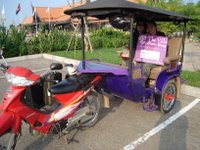Cambodia Fact File:
Country Name: Kingdom of CambodiaCapital City: Phnom Penh
Government: Constitutional Monarchy
Important/Major Cities: Siem Reap (gateway to the temples of Angkor), Sihanoukville (port and beach town), Battambang, Kampong Cham
International Airports: Phnom Penh, Siem Reap
Language: Khmer, secondarily English and French
Ethnic Groups: Khmer (90-95%), ethnic-Chinese, Cham, ethnic-Vietnamese, several ‘hill tribes’ in the northeast
Religion: Theravada Buddhism (97%), Islam, Christianity, Animism
Population of Cambodia: 13.1 million (2001 estimate)
Land Area of Cambodia: 181,035 sq. km.
Land Area of Siem Reap: 10,299 sq. km.
Currency: Riel (US$1=~4100R). US dollars are as commonly used as riel
* * *
Thank goodness the Philippines and Cambodia are ASEAN member countries. While the passengers from non-ASEAN countries aboard our flight (or about 98 percent of the passengers) lined up to get their visas, we humble citizens of the Philippines were led straight to the immigration counter for the stamping of our passports.
The 3-month old Siem Reap International Airport is small yet charming and pristine, easily putting all the Philippines’ airports to shame. As a gateway to the provincial capital of Siem Reap Town, it offers a very enchanting welcome to its guests and gives a very a unique and local touch to what is otherwise a borderless, international, and cosmopolitan structure. They may be poorer than the Philippines, but their airport still does very well in welcoming and whetting their guests’ imaginations. Maybe it’s because the airport is brand-spankin’ new (it opened just last August 2006), but still, we believe this doesn’t give Philippine airports a very good excuse for looking so sloppy.
Buddha installation (made of wrought iron or some similar material) adorning the airport's ceiling
Clean and spacious, the airport features a number of real artifacts from the temples
The tuk-tuk ride to The Villa, our home in Siem Reap, took about 30 minutes from there, courtesy of our beloved tuk-tuk driver, Mr. Lim Hav. (The airport is 6 kilometers from the town center.) Early mornings in Siem Reap are cool, albeit dusty, because most of the town’s roads are only partially paved -- revealing the deep, rich red clay soil that would be as common a sight to us as the temples. Riding the open tuk-tuk during the duration of our trip meant dealing with the dust clouds head-on, which was probably the only thing we didn’t find so endearing about Cambodia.

Our purple tuk-tuk
The airport as gateway to the provincial capital is of course, rather deceiving, as we soon found out. Along the dusty road the scenery resembled that of rural areas in the Philippines, with little wooden stalls selling various knick-knacks, gasoline in soft drink bottles, and other such small items. Here and there were tents housing various celebrations, most probably weddings, because November is wedding month there, we were told.
Further on we entered what seemed like the tourist belt of the town, a great contrast to the rural offerings of the road behind us. The change in scenery was anything but slight. Suddenly there were more people on the road, most of them on bicycles (just like in China or Vietnam). On each side of the road hotels seemed to have sprouted one after another, each boasting grand – sometimes to the point of being gaudy – structures, akin to the designs of the more popular temples. If anything, these hotels are sure indications that tourism is the lifeblood of the city.
As we approached the town proper the neighborhood again turned into a rather rural setting, but this time with the big, swanky hotels side by side smaller guesthouses, souvenir shops, restaurants, markets, etc. It was here where life in Siem Reap Town was abuzz, and where the influences of varying cultures converged. (The town is actually a cluster of old pagoda villages later overlain with a French colonial-era center. Colonial and Chinese-style architecture can be found in the town’s Old French Quarter and Old Market.)





No comments:
Post a Comment